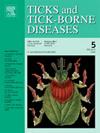犬棘头蜱对不同杀螨剂的敏感性
IF 3.4
2区 医学
Q2 INFECTIOUS DISEASES
引用次数: 0
摘要
棕色狗蜱是广泛存在于狗的体表寄生虫,也可能感染其他脊椎动物宿主,包括人类。对这些蜱虫的控制主要是使用杀螨剂。在本研究中,我们评估了rutilus对不同杀螨剂(amitraz、氟虫腈、伊维菌素和氯菊酯)的敏感性。充血的雌性蜱虫(n = 36)根据其来源分为三组(G1 -来自私人收容所的未经治疗的狗;G2 -氯菊酯处理的私人狗窝;(3)氟虫腈、氨咪唑和(5)甲氧丁二烯处理的狗),并在控制温度和湿度的条件下进行产卵。采用幼虫包试验法,对咪唑(AMZ)、氟虫腈(FIP)、伊维菌素(IVM)、氯菊酯(PTR) 4种药剂的杀螨效果进行了评价。我们的数据表明,所有犬群的rutilus幼虫都对IVM敏感。G1期幼虫对IVM和PTR敏感,对AMZ和FIP耐受;G2幼虫对FIP和IVM敏感,对AMZ和PTR抗性;G3幼虫对AMZ、PTR和IVM敏感,对FIP抗性。这些结果证实了意大利南部rutilus幼虫对AMZ、PTR和FIP存在抗性。这表明有必要监测南欧棕色狗蜱的杀螨剂耐药性,以制定更好的长期控制该地区蜱虫的策略。本文章由计算机程序翻译,如有差异,请以英文原文为准。
Susceptibility of Rhipicephalus rutilus ticks from dogs to different acaricides
Brown dog ticks (Rhipicephalus sanguineus sensu lato) are widespread ectoparasites of dogs and may also infest other vertebrate hosts, including humans. The control of these ticks is primarily carried out using acaricides. In this study, we assessed the susceptibility of Rhipicephalus rutilus to different acaricides (i.e., amitraz, fipronil, ivermectin, and permethrin). Engorged female ticks (n = 36) were divided into three groups based on their origin (i.e., G1 – untreated dogs from a private shelter; G2 – permethrin-treated private dog shelter; and G3 - fipronil, amitraz, and (S)-methoprene treated owned dogs) and kept under controlled temperature and humidity for oviposition. The acaricidal effects of amitraz (AMZ), fipronil (FIP), ivermectin (IVM), and permethrin (PTR) against R. rutilus were evaluated using the larval packet test, with subgroups of tick larvae in each experimental assay. Our data indicate that R. rutilus larvae from all dog groups were susceptible to IVM. In particular, larvae from G1 were apparently susceptible to IVM and PTR, and tolerant to AMZ and FIP; larvae from G2 were susceptible to FIP and IVM and resistant to AMZ and PTR, while larvae from G3 were susceptible to AMZ, PTR and IVM, and resistant to FIP. These results confirm the occurrence of resistance to AMZ, PTR, and FIP in R. rutilus larvae from southern Italy. This suggests the need to monitor acaricide resistance in brown dog ticks in southern Europe to develop better strategies for the long-term control of ticks in this region.
求助全文
通过发布文献求助,成功后即可免费获取论文全文。
去求助
来源期刊

Ticks and Tick-borne Diseases
INFECTIOUS DISEASES-MICROBIOLOGY
CiteScore
6.90
自引率
12.50%
发文量
185
审稿时长
6-12 weeks
期刊介绍:
Ticks and Tick-borne Diseases is an international, peer-reviewed scientific journal. It publishes original research papers, short communications, state-of-the-art mini-reviews, letters to the editor, clinical-case studies, announcements of pertinent international meetings, and editorials.
The journal covers a broad spectrum and brings together various disciplines, for example, zoology, microbiology, molecular biology, genetics, mathematical modelling, veterinary and human medicine. Multidisciplinary approaches and the use of conventional and novel methods/methodologies (in the field and in the laboratory) are crucial for deeper understanding of the natural processes and human behaviour/activities that result in human or animal diseases and in economic effects of ticks and tick-borne pathogens. Such understanding is essential for management of tick populations and tick-borne diseases in an effective and environmentally acceptable manner.
 求助内容:
求助内容: 应助结果提醒方式:
应助结果提醒方式:


